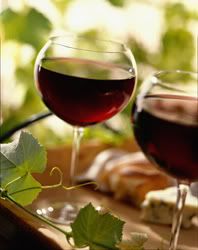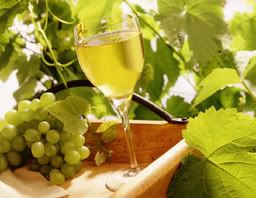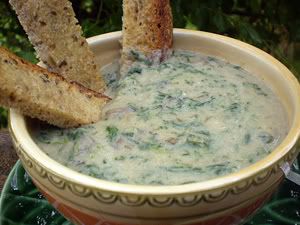Bryanna Clark Grogan’s Vegan Feast Kitchen/ 21st Century Table: The kitchen journal of a vegan food writer.. I'm on Facebook and Twitter (see links in sidebar at right).
Monday, October 1, 2007
SYNERGIZING UMAMI-- COOKING WITH WINE AND HOW TO MAKE VEGAN FLAVOR EXPLODE!


photo by John Kelly
I was making a quick saute for dinner the other night with my crispy Marinated tofu (Breast of Tofu) and a simple sauce of sauteed chanterelle mushrooms, garlic, herbs, broth, and dry white wine, when it entered my mind that many vegan recipes I see don't utilize wine. Interesting, I thought-- I use it all the time! I thought about this more while I enjoyed the dish with some orzo pilaf-- full-bodied and absolutely smashingly delicious in spite of its simplicity.
I lived in a winery in central California from age four to eleven. My mother had unlimited amounts of excellent wine to cook with, so I developed a taste for the rich flavor that wine lends to food. Later, when I became a vegan, I realized that wine was a powerful flavor enhancer, giving many meatless dishes a character and body that they lacked without it. But I didn’t know why that was so.
I used to think that it was perhaps the fruity flavor and the acidity of wine that worked the magic. But it’s more than that. It's the "fifth flavor"-- umami. (Read all about it here. And about recent umami discoveries further down.) Wine contains umami compounds because it is a fermented substance, and umami is a flavor enhancer. But, beyond umami, wine contains alcohol, and alcohol is a powerful flavor extractor. Some flavor components dissolve in water, and others in fat. But alcohol dissolves not only water-soluble and fat-soluble flavors, but also flavors that dissolve in neither water nor fat.
This capacity is a wonderful boon to low-fat cooks, because, without it, we lose the fat-soluble flavors (which is why fat-free foods often taste boring). No wonder I reach for a wine bottle when a dish is missing that special something!
When you splash some wine into the pan to scrape up the browned bits, you are not only getting the flavors of the wine and the caramelized bits (double umami—8 times the flavor!), but you are also releasing some extra flavors that only alcohol can extract! How neat is that?
What about when the alcohol boils off? Well, take the case of the famous pasta sauce made with tomatoes and vodka. This liquor is rather tasteless, but it does contain a lot of alcohol. The alcohol probably releases some flavor component in the tomatoes (more umami compounds), which releases into the sauce. Then it doesn’t matter if most of it boils off.
Worried about alcohol in your food? I have to tell you that I am not a drinker! I have a very low capacity for alcohol (1 glass of wine is about my limit)-- it makes me sleepy. I have never been drunk, I confess it! And this is in spite of the fact that my mother's California-French-Italian fusion cooking almost always contained wine! We even had sherry in our creamed tuna on toast (a favorite dish in the 1950's-- I'm dating myself...oh, well!). So, obviously, this didn't turn me into a wino!
The rate of alcohol evaporation depends on several factors: the intensity of heat; the length of cooking time; the pot or pan (greater surface area exposed means greater evaporation— for instance, the same dish cooked in a 10-inch skillet will retain more alcohol than that cooked in a 12-inch skillet); exposure to air; other ingredients in the recipe (breadcrumbs, for example, may absorb alcohol and protect it from the heat); and the stage at which the alcohol is added during cooking. In most cases, some alcohol is retained in the dish. Flambéing removes about 25% of the alcohol; simmering on a stovetop for 1/2 an hour evaporates about 65%; 2 and 1/2 hours of simmering removes about 95%.

photo by John Kelly
MORE ABOUT UMAMI IN WINE AND OTHER PLANT FOODS:
Since I wrote the article I linked to above, there has been a lot more research on umami. We get umami compounds (which means “delicious” combined with “essence”, and is used in Japan to describe a food that reaches a state of perfection) in many food-born substances.
From the 1950’s on, umami-triggering nucleotides have been found. In 1998, two leading Japanese researchers, Yamaguchi and Ninomiya, published a list of 39 substances they believed to trigger umami, including amino acids, ibotenic and tricolomic acids, succinic acid, theanine, and an octopeptide (compound of 8 amino acids).
Dr. Shintaro Kodama was the first researcher to discover a quality called synergy in some nucleotides, which dramatically intensified the qualities of umami compounds, thus explaining the “flavor explosion” I mentioned in the article. And we know now that browning protein-rich foods, such as a golden-brown crust on bread, or the aging of wine or vinegar, the brewing of beer, the reducing of stock, the fermenting of a bread starter, etc., etc., produce hundreds of compounds that enhance umami even further, producing complex tastes and aromas. Aged wines, sake and distilled spirits develop more umami compounds and can contribute more than flavor to foods—they contribute balance and enhancement of other flavors.
Some plant foods that are rich in free amino acids and have lots of umami taste when raw are: sea vegetables, corn, peas, tomatoes, mature potatoes, bell peppers, winter squash, nuts and seeds. Other plant foods benefit from cooking or fermenting (such as making cabbage into sauerkraut, or pickling vegetables), which increases the umami taste, or can be paired with stronger umami foods, such as a salad dressing. Soy foods increase in umami taste when they are roasted, cooked, or fermented, because they are one of the most protein-rich foods around. Soy sauce, roasted soy beans, miso and, various other fermented Asian bean pastes, and fermented tofu deliver a great umami punch even when used in small amounts.
Mushrooms and fungi are a great source of synergizing umami, and, generally speaking, the darker the color, the more umami. Dried mushrooms pack an even greater punch. Yeasts (both active and non-active nutritional yeast and yeast extract, such as Marmite), which is also a fungi (and includes sourdough, a natural yeast), have umami compounds. They also act as synergizers. For instance, in a live yeast or sourdough starter, the enzymic action develops the umami in wheat flour to “ripen” the dough and develop its flavor.
I'm sure that there will be more discoveries to come! In the meantime, we can use this knowledge to expandf the flavor possibilities of vegan foods! (Can you tell I get excited about this?)
SUBSTITUTES:
Absolutely can't use wine or other alcohol, even in cooking? I would recommend using a non-alcoholic wine, because it is fermented before the alcohol is removed. It won't have the flavor-releasing qualities of alcohol, but it will contain umami compounds. See http://nypost.com/2015/01/10/non-alcoholic-beer-and-wine-are-hot-but-do-they-taste-good/ But you'll have to contact the manufacturer to find out if any animal products are used in the wine-making process. http://nypost.com/2015/01/10/non-alcoholic-beer-and-wine-are-hot-but-do-they-taste-good/
VEGAN WINE?
For brands, check out http://www.barnivore.com/wine, "Your vegan wine, beer, and liquor guide"

I made this soup for lunch today in a big hurry. It combines umami compounds in mushrooms, bouillon, and white wine for a delicious meal!
Printable Recipe
BRYANNA'S CREAMY POTATO, MUSHROOM AND SPINACH BISQUE (WW CORE PLAN-COMPATIBLE)
Servings: 4
This is something I created on the spur of the moment with things I needed to use up, and I needed lunch FAST. It's delicious with wholewheat sourdough toast. The mushroom broth and wine make this quick soup very flavorful.
2 tsp olive oil
1 medium onion, chopped
2 cloves garlic, chopped
2 cups chopped cremini or portobello mushrooms (scrape the gills out of portobellos with the side of a spoon)
1/2 cup dry white wine (can be non-alcoholic) OR white vermouth
1 cup homemade mushroom broth OR use vegetarian bouillon with 1/2 Tbs. Pistol River Porcini Mushroom Powder added
2 cups non-dairy milk (use a nice, creamy one, or use half non-dairy milk and half vegan creamer)
1 tsp salt
1/2 tsp dried thyme
freshly-ground black pepper to taste
1/3 to 1/2 cup mashed potato flakes (You can buy organic vegan flakes in some HF stores, or from amazon or veganessentials.com [which ships to Canada at a reasonable price].) (1/2 cup makes quite a thick soup) OR, if you have no potato flakes, use 1/2 to 3/4 cup plain mashed potatoes
1/4 cup squeezed, thawed frozen or cooked, chopped spinach OR chard
(I had some home-cooked spinach in the freezer that I used, so I can't tell you how many ounces it was raw, unfortunately. I measured it squeezed quite dry.)
In a small soup pot, heat the oil, and then add the onions and garlic. Stir-fry until the onion starts to soften, and add the mushrooms.
Stir-fry briefly, then add half of the wine and let it cook off. Add the remaining wine, thyme, salt and pepper. Stir in the soymilk, and then the potato flakes, the smaller amount first. Remember that this soup will thicken as it stands. Stir in the spinach, heat through, and serve immediately.
Nutrition Facts
Nutrition (per serving): 118.3 calories; 25% calories from fat; 3.6g total fat; 0.0mg cholesterol; 552.9mg sodium; 450.4mg potassium; 13.1g carbohydrates; 2.3g fiber; 5.3g sugar; 10.8g net carbs; 5.6g protein; 2.2 points.
Salud!

Labels:
soup,
umami,
vegan wine,
Weight Watchers Core Plan,
wine
Subscribe to:
Post Comments (Atom)
5 comments:
Hi Bryanna,
I finally have time to come visit blogland again. The first place I came was your blog to see all the great stuff I have missed. I am in a position in which I teach health and nutrition to 230 kids each semester. They have made your smoothies, your whole grain pancakes, your green beans and soon yuor fruit pizza style dessert. I love what I do, but as with any new job done for the first time it is time consuming. I finally came to a place in my new work life this week in which I was able to cook for myself every day instead of take out and baked potato/ salads.
Love your work. THANKS!!
So good to hear from you, Dori! Have missed you on the veg Feast forum and your blog, but I knew you must be very busy! I find it hard to blog once a week! What great work you are doing, Dori, but I'm so glad you have some time to be at home, however briefly! All the best, Bryanna
Good God that looks tasty! We have an upcoming soup cook-off and I am tempted to try this one... Great site!
Hi Bryanna, another great blog post! Thanks, as always. I am curious about one thing in your recipe - why do you scrape the mushroom gills out?
Bettina, it's a matter of personal preference and the type of dish. Most experts advise if you're going to stuff them or don't want to darken the color of your dish. If you're going to grill them, the whole mushroom collapses and flattens out so it won't make much of a difference. The gills can darken light-colored sauces and dishes and some people think they have a "muddy taste. Some cooks save the gills in the freezer to add to homemade vegetarian stock.
Post a Comment